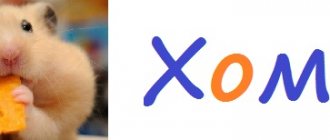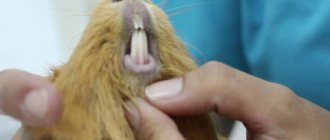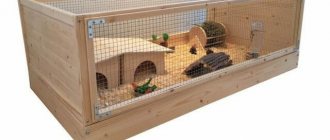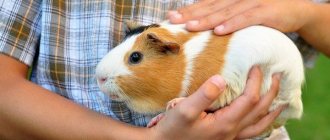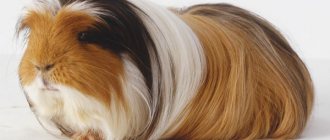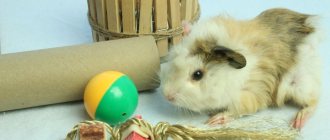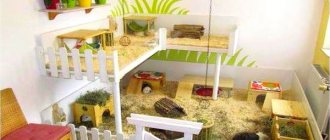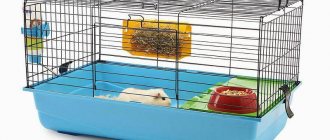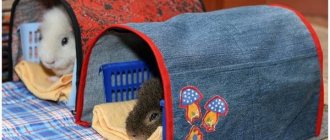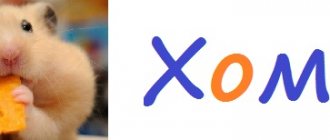A pet's illness becomes a real challenge. I want to help my pet as quickly as possible, but I don’t always have an understanding of how and what can be done. In some cases, you can independently diagnose the disease based on symptoms, in others you need the help of a qualified specialist. Hair loss is quite common among animals. Most causes can be diagnosed independently. Today we will talk about lichen in guinea pigs.
The source of the disease is a fungus that can be transmitted to other animals and people. Ringworm is accompanied by hair loss in the affected areas, peeling and redness of the skin, and severe itching.
If guinea pig shingles are not treated in time, it will quickly spread throughout the body. In this case, you can become infected through contact with an animal, a cage or its contents. In later stages, the virus spreads easily.
There are two types of lichen in guinea pigs: trichophytosis and microsporia. Both can remain dormant for a year and a half, while on the animal or surrounding objects. The carrier may not show any signs of infection. Activation of the fungus is facilitated by unsanitary conditions or weak immunity of the guinea pig.
Fungus in guinea pigs: symptoms and treatment
(photo by Lindsaymarie.) Fungal infections
(dermatophytes, ringworm) often begin on the face. Flaky areas covered with scales, causing itching and hair loss. Such areas can be on the body, ears and paws. There may be red, inflamed areas with matted fur. Which, when dried, become dry and scaly.
Dermatophytes include Trichophyton sp., Epidermophyton sp., Microsporum sp. These microorganisms affect the stratum corneum of the epidermis, nails and hair.
Other fungal infections, such as candidiasis, pityriasis versicolor and cladosporiosis, can also occur with damage to keratinocytes, but they are not classified as dermatophytosis.
The pathogenicity of all dermatophytes is low.
Stress, poor nutrition, environment, heat, moisture in bedding and air, concurrent infection with external and internal parasites, age (elderly or toddler), pregnancy can all predispose animals to infection.
Prevention of fungal disease includes:
timely treatment against external and internal parasites, provide good quality succulent feed, grain and hay, change bedding on time, reduce air humidity. Humid climates are especially problematic for guinea pigs. The incubation period for lichen is 7-14 days after infection. This fungus releases a huge number of spores into the environment, which can remain dormant for several months. Spores can be introduced with food, bedding, other animals, on hands and clothes.
A scraping taken and examined under a microscope, or a Wood's lamp examination will help establish the correct diagnosis and prescribe treatment. If you have already started to smear something, then the test results will no longer be returned. The picture will be unclear.
(photo by Jandras, cream treatment)
- A sick animal must be transplanted to a separate place to live. Ideally a terrarium (Dune) to avoid the spread of spores.
- The terrarium is regularly disinfected during treatment. Toilet duck or domestos. Leave for 15 minutes and rinse thoroughly.
- When handling animals, wear a change of clothes, wash your hands thoroughly or use rubber gloves.
Creams, ointments, sprays, solutions:
Fungoterbin cream 1%
— Has a wide spectrum of antifungal action. It has a fungicidal effect against dermatophytes, molds and some dimorphic fungi. Activity against yeast-like fungi, depending on their type, can be fungicidal or fungistatic. The mechanism of action of the drug is to disrupt the biosynthesis of ergosterol occurring in fungi in the early stages. This leads to ergosterol deficiency and intracellular accumulation of squalene, which causes the death of the fungal cell. A decrease in the severity of clinical manifestations is usually observed in the first days of treatment.
Thermikon cream 1%
- white, homogeneous, with a weak specific odor.
Thermikon with prey for external use 1%
- in the form of a transparent, colorless or light yellow liquid with a characteristic odor of ethyl alcohol.
Pharmacological action Antifungal drug, allylamine. Has a wide spectrum of antifungal action. Active against dermatophytes:
Trichophyton rubrum, Trichophyton mentagrophytes, Trichophyton tonsurans, Trichophyton verrucosum, Trichophyton violaceum, Microsporum canis, Epidermophyton floccosum.
In low concentrations, it has a fungicidal effect against dermatophytes, molds (Aspergillus, Cladosporium, Scopulariopsis brevicaulis) and some dimorphic fungi. Activity against yeast fungi of the genus Candida and their mycelial forms, depending on the species, can be fungicidal or fungistatic. Thermikon is also active against
Pityrosporum orbiculare (also called Malassezia furfur), the causative agent of pityriasis versicolor. Thermikon disrupts the synthesis of ergosterol occurring in fungi by inhibiting the enzyme squalene epoxidase located on the cell membrane of the fungus. This leads to ergosterol deficiency and intracellular accumulation of squalene, which causes the death of the fungal cell.
Fukortsin (
Castellani liquid)
- The solution has a characteristic bright crimson color.
Pharmacological action:
Combined preparation for external use. Has antimicrobial and antifungal effects. (Acts slower than thermikon and gets dirty)
Skin diseases caused by parasites
Lice and lice eaters
These parasites are especially common in guinea pigs. The first symptoms are severe itching. To detect lice and lice, it is worth examining the skin and fur of the animal under a magnifying glass. If your guinea pig is infested with lice, you will see larvae among the hairs. Nits have a pear-shaped body and measure half a centimeter. Lice eaters are much smaller - the length of an adult insect is about a millimeter. They feed not only on skin scales, but also on the blood of the animal.
It is impossible to comb out insects with a regular brush.
Insecticides are a good way to control parasites. The guinea pig should be placed in a 1% netritonate solution or in a 0.5% bromocyclene solution for several minutes. The procedure should be repeated every seven days for three weeks. Before the procedure, you should also treat the cage with a bromocyclene solution and change all the bedding.
Fungal diseases
Fungus in guinea pigs can often be observed on the face. The first symptoms are hair loss, itching, peeling of the skin. After the muzzle, the fungus affects the paws, ears, chest, and neck. The first type of fungus is dermatophyte. It affects the nails, hair and the stratum corneum of the epidermis of the skin.
Weakened animals, as well as pregnant and lactating females and young individuals are susceptible to infection.
Prevention of the disease includes:
- regular cleaning of the cage and change of bedding (the fungus actively multiplies in a dirty environment),
- high-quality and clean feed,
- low humidity in the room where the animal is kept,
- regular treatment for internal parasites.
If the veterinarian has determined the presence of a fungus - dermatophyte, then the sick animal must be transplanted into a separate cage (it is better to use a terrarium or an aquarium to avoid the spread of spores). The cage where the guinea pig was kept must be thoroughly washed with any chlorine-containing solution. For treatment, you can use Nizoral shampoo, which is sold in pharmacies. It has a good antifungal effect, reduces itching and eliminates skin flaking. Apply the shampoo to the fungus-affected areas of the body for a few minutes, then rinse with warm running water.
Dandruff
Dandruff in guinea pigs is not a separate disease, but a consequence of an existing health problem. The cause of dandruff can be poor nutrition, dirty bedding, weakened immunity, metabolic problems, diseases of internal organs, as well as damage to skin parasites and fungi. To more accurately determine the cause of dandruff, you should consult a doctor and begin treatment by eliminating the underlying disease. Nizoral shampoo usually helps with dandruff. The animal is bathed in a shampoo solution once a week and the procedure is repeated until the dandruff completely disappears. It is also good to wipe your guinea pig's fur twice a day with Betadine solution. Treatment of dandruff involves correcting the animal's diet - any fatty foods should be completely eliminated, more green grass and sprouted grains, fruits and alfalfa meal should be given.
Guinea pig in your home. Maintenance, nutrition, health of a guinea pig.
Fungus on the skin.
Causes: occurs from a weakened immune system. This is facilitated by a poor diet, stress, and poor living conditions. Dirty litter provides fertile soil for the proliferation of fungal spores. If pigs are kept in close quarters, skin fungus can easily affect all animals.
Fungus in guinea pigs: symptoms and treatment
(photo by Lindsaymarie.)
Fungal infections
(dermatophytes, ringworm) often start on the face. Flaky areas covered with scales, causing itching and hair loss. Such areas can be on the body, ears and paws. There may be red, inflamed areas with matted fur. Which, when dried, become dry and scaly.
Dermatophytes include Trichophyton sp., Epidermophyton sp., Microsporum sp. These microorganisms affect the stratum corneum of the epidermis, nails and hair.
Other fungal infections, such as candidiasis, pityriasis versicolor and cladosporiosis, can also occur with damage to keratinocytes, but they are not classified as dermatophytosis.
The pathogenicity of all dermatophytes is low.
Stress, poor nutrition, environment, heat, moisture in bedding and air, concurrent infection with external and internal parasites, age (elderly or toddler), pregnancy can all predispose animals to infection.
Prevention of fungal disease includes:
timely treatment against external and internal parasites, provide good quality succulent feed, grain and hay, change bedding on time, reduce air humidity. Humid climates are especially problematic for guinea pigs. The incubation period for lichen is 7-14 days after infection. This fungus releases a huge number of spores into the environment, which can remain dormant for several months. Spores can be introduced with food, bedding, other animals, on hands and clothes.
A scraping taken and examined under a microscope, or a Wood's lamp examination will help establish the correct diagnosis and prescribe treatment. If you have already started to smear something, then the test results will no longer be returned. The picture will be unclear.
(photo by Jandras, cream treatment)
- A sick animal must be transplanted to a separate place to live. Ideally a terrarium (Dune) to avoid the spread of spores.
- The terrarium is regularly disinfected during treatment. Toilet duck or domestos. Leave for 15 minutes and rinse thoroughly.
- When handling animals, wear a change of clothes, wash your hands thoroughly or use rubber gloves.
Creams, ointments, sprays, solutions:
Fungoterbin cream 1%
— Has a wide spectrum of antifungal action. It has a fungicidal effect against dermatophytes, molds and some dimorphic fungi. Activity against yeast-like fungi, depending on their type, can be fungicidal or fungistatic. The mechanism of action of the drug is to disrupt the biosynthesis of ergosterol occurring in fungi in the early stages. This leads to ergosterol deficiency and intracellular accumulation of squalene, which causes the death of the fungal cell. A decrease in the severity of clinical manifestations is usually observed in the first days of treatment.
Zhiroviki
A wen most often results from the removal of a lipoma, an abscess, or appears due to infection entering a small wound. If over time the wen does not grow and does not cause any discomfort to the animal, then it does not need to be removed. However, if the wen is painful and significantly increases in size, you should immediately consult a doctor.
The wen can break out on its own and this can lead to not the most pleasant consequences - the formation of tumors under the wen, incomplete release of pus, blood poisoning.
The veterinarian removes not only the wen itself, but also the fat sac. It is this that most often becomes the cause of the recurrence of the wen and the development of tumors. Typically, after surgery, the veterinarian will prescribe a course of antibiotics and complete rest. The wound should be lubricated with ointment and washed with a solution of hydrogen peroxide.
What is it and what does it look like?
Ringworm is a dermatological viral disease caused by the active growth of fungal cells. A disease occurs on the skin. The first symptom is:
- hair loss;
- peeling;
- redness;
- itching
If you do not help your guinea pig in time, the lichen will quickly spread throughout the rodent's entire body. In addition, other animals living in the same cage with the patient, as well as the animal’s owners, are at risk of infection.
A loving owner always worries when a pet is unwell. When faced with a similar problem for the first time, the question will invariably arise of how to deal with the virus.
Guinea pigs are susceptible to two types of lichen:
Spores of both fungi can be stored for quite a long time on the skin of animals, in the soil, on objects before becoming active.
at all necessary that the carrier animal will suffer from any type of lichen. Most often, the disease progresses on the body of animals that are kept in unsanitary conditions or have weak immunity.
Types of lice
Oddly enough, the varieties of lice in pigs are quite numerous. In practice, in almost 99% of cases, only two types are found, and another one is diagnosed much less frequently:
- Typically, “pigs” are parasitized by two types of lice: Gliricola porcelli and Gyropus ovalis.
- In extremely rare cases, parasites of the species Trimenopon hispidium can be found on the body of an animal.
G. Ovalis are more compact in shape (as their name suggests), but in all other respects they are very similar to the previous variety.
Trimenopon hispidium, then this type of lice is extremely small and most often they are simply not noticed. However, in cases of severe infestations, you can see large accumulations of these parasites, vaguely reminiscent of tiny spiders.
Symptoms and diagnosis
The symptoms of deprivation are as follows:
- hair loss in small patches;
- the affected areas turn red, sometimes covered with raised spots with a heterogeneous structure;
- the skin begins to peel off, becoming covered with sores;
- the guinea pig intensively scratches the areas affected by lichen;
- the edges of fungal wounds are smooth, but asymmetrical.
In order to correctly diagnose the disease, the following methods are used:
- Examination of damaged areas of the body is carried out using a UV lamp. In case of infection with trichophytosis, the hairs will glow a little, but with microsporia there is no such glow.
- Fragments of wool are taken for analysis for careful examination under a microscope.
- The most accurate is considered to be scraping from bald areas of the body or scabs that have formed.
- At home, you can diagnose lichen by circling the affected area of the body with a cotton swab treated with iodine. The fungus will have visible edges, unlike other skin diseases that do not have such a feature. But this method can only be used if there are no wounds or cracks on the guinea pig’s body.
But you shouldn’t delay visiting the veterinary clinic; sooner or later, the animal will have to be shown to a doctor.
Abscess
An abscess is an inflammation of purulent tissue with the formation of purulent cavities in the muscles, bones and subcutaneous layer. Abscess in a guinea pig is a common disease, and the most common cause is wounds resulting from fights with other pigs, punctures from hay, wounds on the lips caused by excessively sharp teeth. The abscess looks like a fairly large and soft tumor. Treatment of an abscess can only be surgical. The complexity of the operation depends on the location of the tumor. If the tumor has just appeared, then simply removing the pus and treating the wound with Levomekol ointment will be sufficient. However, some types of abscess require complex abdominal surgery to remove the affected tissue. In such cases, the animal requires a long course of treatment with antibiotics.
During the recovery period, the guinea pig needs rest, soft bedding and proper nutrition - more succulent food containing vitamin C should be given.
Some breeders try to remove the abscess themselves at home. Sometimes this method gives good results, but independence can also play a cruel joke. An inexperienced person can easily confuse an ordinary purulent abscess with a more complex formation - a lipoma, the removal of which should occur exclusively in a hospital setting and under general anesthesia. Lipoma is a benign tumor that usually does not cause complications after removal.
Treatment methods
Before starting treatment, the sick animal should be transplanted into a separate cage or enclosure. Everything that the guinea pig has had contact with must be thoroughly washed with disinfectants.
If there is fabric bedding in the cage, it is boiled. But it’s best to burn it and replace it with a new one. The edges of the lichen need to be freed from hair by having a small haircut. Do not forget to use gloves during all of the above steps.
Treatment with medications should only be prescribed by a veterinarian after an accurate diagnosis has been made. Most often, it is prescribed to treat the surface of the lichen with a solution of Chlorhexidine, and then lubricate it with ointments against the fungus. Medicines that are usually used to treat lichen in guinea pigs:
- Clotrimazole;
- Thermikon;
- Miconazole.
The preparations are applied, covering 1.5-2 centimeters of healthy skin. If the disease is quite advanced, then in addition to ointments, medications are prescribed for oral administration.
In addition, guinea pigs are recommended to be given ascorbic acid and Gamavit during therapy to restore vitamin balance and strengthen the immune system.
Prevention
First of all, you need to protect yourself and your children, since lichen is transmitted to humans. Wear disposable gloves for any contact. The guinea pig is resettled separately and its home is completely disinfected. If possible, boil the bedding and all contents of the cage.
The disease could have started due to a large amount of dust in the room. Don’t forget to do general cleaning and airing of the apartment regularly. This will preserve the health of all residents.
Folk remedies
Instead of pharmaceutical drugs, fungal infections in guinea pigs are treated with folk remedies. The only disadvantage of this treatment is the long period.
best in folk therapy. To do this you need:
- take a clean cup and a white sheet of paper, without any blots or inscriptions;
- burn it on a plate;
- after combustion, a brownish resin-like residue will remain on the surface;
- This substance is lubricated on the affected areas of the skin.
You should be especially careful not to burn the animal or your own fingers. It is best to perform the procedure using cotton swabs.
In addition,
it helps to wash guinea pigs with tar soap. After this, the fungus-prone areas are lubricated with iodine.
Baking soda and table salt can help in treatment. They should be mixed in a 1:1 ratio, and the resulting mixture is used to treat the animal’s skin.
You can also prepare a cream from chopped dark raisins and vegetable oil.
It is important to understand that folk remedies should be used extremely carefully in the treatment of lichen in guinea pigs.
Photo of what a guinea pig with lichen looks like
If you find signs of lichen infection in your pet, you should not self-medicate for a long time, so as not to aggravate the animal’s already difficult situation. To make a correct diagnosis, it is best to take your guinea pig to a veterinary clinic for an examination and testing. Only timely, qualified assistance will benefit your furry friend.
Summing up
Thus, there are many ways to treat shingles. However, for their comprehensive use, not to mention a qualified diagnosis, you should definitely consult a specialist. Treating your guinea pig on your own can only make the problem worse.
In any case, it is worth remembering about preventive measures. The best way to preserve the mood, time and money, as well as the health of your beloved pet, is to simply prevent him from getting sick.
Source
